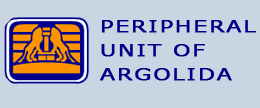The Monastery of St Demetrios Aygou (Iria)
|
Over the plains of the region of "Iria", on the north of the mountain "Aygo" or "the Egg", probably owing to its shape or some technique for ground measurements, lies the monastery, closely knit with the river "Rados", which can be sailed, should one wish to reach the monastery from its liquid route. Alternatively, the route is through the village, called "Pelei", which as in the first case point, it leads to a rugged gravel road, straight to the sanctuary. |
||
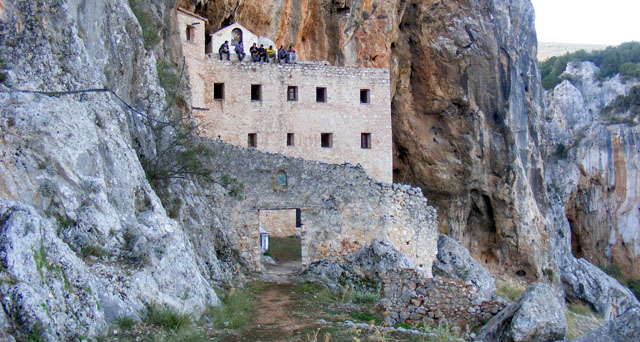 |
||
| Much has been said, rumors have been cast, and stories have been woven by locals, who have propagated with the passage of time, regarding both the steepness of the place as well as its nickname, "Aygo". Initially, it has been alleged that the decision for the church's erection had been made for another area, yet, St. Demetrios, himself had designated the current position as the orthodox one. Construction workers given the green light to assemble in the former place would see their tools mysteriously transported to the latter, divinely determined one.
The term "Aygo" is claimed to have been defined so due to early Christians of the period to upright confirmation of the monastery's setting, which is why they threw an egg to see whether it would crumble and crumble it did not. This rather awkward technique was decisive for the formation of the church. There is also this assumed story of a mother, according to the locals, who had a dying child so she turned to Virgin Mary for help and prayed she did. It seems that she had a vision of Virgin Mary ordering her: "show me your belief by throwing your child off the cliff and it shall heal itself". The woman then thought about throwing an egg off to see if it would shatter and it did not. She threw her baby and it got killed. However the closest to reality notion of the term "Aygo" or "the Egg" appears to be deriving from the etymological approach it has in the Greek language, meaning "bare top". |
||
|
No bibliographic notice of any kind has been recorded other than the previous telltales, which quite logically have been enhanced or weakened with the passage of time, regarding the date of the church's assembly. The one and only true deduction can originate from the stonework of the body of the church, nave and aisles' construction made of brick, leading to its formation somewhere around the 11th to 12th century.
The main site of the monastery, deep inside the rocky cavity, is divided into a ground floor and two floors above it, connected with a narrow stone step ladder. On the second floor lies the body of the church, nave and aisles, consisting of a two-nature sanctuary, one dedicated to St. Demetrios the Holy Myrrh Scented and the other one to St. Theodoroi. Sadly, the interior of the former temple has been fire burnt and destroyed. The fire damaged the woodcut icon screen of the church as well as its frescoes. Now both temples communicate through a bilobed opening, which must be mural-painted around the 17th century, about the same period the church of St. Theodoroi has, ensuing the finger-counted few paintings that have survived. |
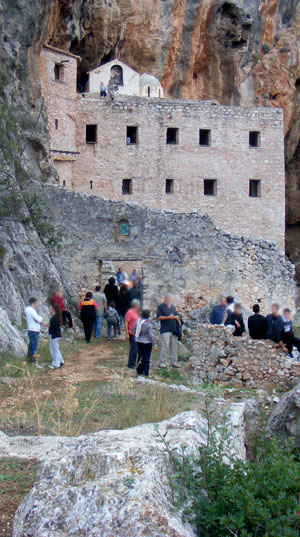 |
|
|
|
||
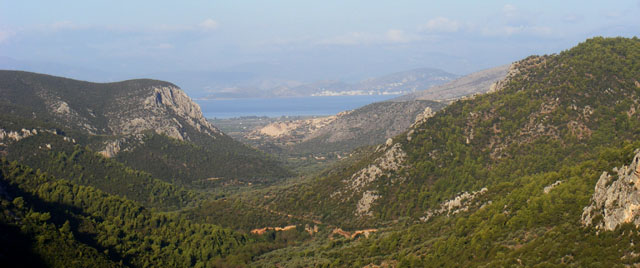 |
||
| The view of the plains from the Monastery | ||
|
The underground part of the monastery seems, based on records to have accommodated at around 1700: sixteen (16) monks and that many servants, 127 horses, 3000 sheep, 800 goats etc. Considerable is the contribution of the monastery and particularly of its Reverend Father, who took an active part on the wage on the town of Nafplio. (The scattered debris of the region around the monastery as well as its architectural style attests to its fortress-like nature). In 1833, the monastery was home to a "Father", three servants and [....].However, the records were destroyed alongside the monastery itself, 'washing away' almost all mysteries of its activity throughout the years.
Presently, the monastery is left abandoned and derelict. As the residents of the region of "Iria" sadly point out, being among the few to try to preserve the monastery: "It is a pity to lay no protection or consideration on such a memorable monument". The exact location of the Holy Church can be tracked in the section: Map |
||
 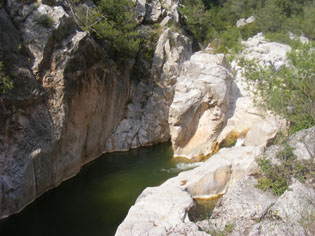 |
||
| River Rados' views | ||



